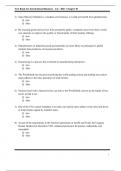Exam (elaborations)
ATI LEHNE’S PHARMACOTHERAPEUTICS FOR ADVANCED PRACTICE NURSES AND PHYSICIAN ASSISTANTS GRADED A+ YEAR 2024 / 2025
- Course
- Institution
ATI LEHNE’S PHARMACOTHERAPEUTICS FOR ADVANCED PRACTICE NURSES AND PHYSICIAN ASSISTANTS GRADED A+ YEAR 2024 / 2025
[Show more]












